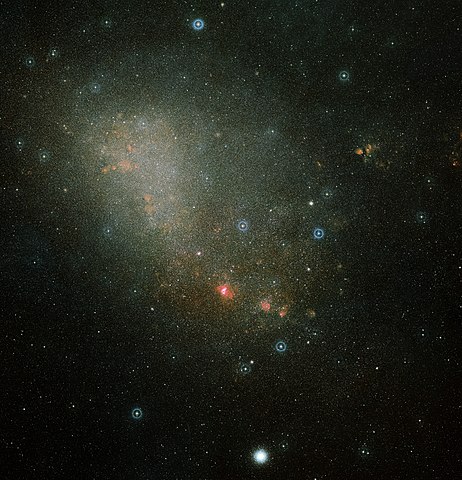The Small Magellanic Cloud (SMC) is a captivating and mysterious dwarf galaxy that orbits our Milky Way. It is one of the Milky Way’s two largest satellite galaxies, the other being the Large Magellanic Cloud (LMC). The SMC offers a unique opportunity to explore a dwarf galaxy and learn about various aspects of the universe. Here are some of the wonders and mysteries of the Small Magellanic Cloud:
1. Irregular Shape:
The SMC has an irregular shape and lacks the well-defined spiral structure of larger galaxies like the Milky Way. This irregularity raises questions about its formation and evolution.
2. Proximity:
The SMC is relatively close to us, located at a distance of approximately 200,000 light-years from Earth. Its proximity allows astronomers to study its stars and other features in detail.
3. Stellar Populations:
The SMC hosts a diverse population of stars, including young, hot, and massive stars, as well as older, cooler stars. The study of these stars provides insights into the galaxy’s history and stellar evolution.
4. Star Clusters:
The SMC contains numerous star clusters, including open clusters and globular clusters. These clusters offer valuable opportunities to study stellar dynamics, ages, and chemical compositions.
5. Active Star Formation:
The SMC is a region of active star formation, with pockets of gas and dust giving birth to new stars. These regions are rich in young, massive stars and are known as “HII regions.”
6. Dark Matter:
Like most galaxies, the SMC is believed to contain dark matter, which exerts a gravitational pull on visible matter. Studying the distribution of dark matter in the SMC is essential for understanding its dynamics.
7. Magellanic Bridge and Stream:
The SMC is connected to the LMC and the Milky Way by a bridge of gas and stars. There is also a trailing stream of stars and gas extending from the SMC, both of which are results of gravitational interactions.
8. Interaction with the Milky Way:
The SMC is gravitationally bound to the Milky Way, and the two galaxies are in a dynamic interaction. This interaction plays a role in shaping the SMC’s structure and may influence its future evolution.
9. Ancient Observations:
The Small Magellanic Cloud has been known to astronomers since ancient times, with Indigenous Australian cultures recording its presence. It has played a significant role in human understanding of the cosmos.
10. Cosmic Laboratory:
Dwarf galaxies like the SMC serve as cosmic laboratories for studying galaxy formation, evolution, and interactions. They provide valuable insights into the processes that shape galaxies in the universe.
Unveiling the wonders and mysteries of the Small Magellanic Cloud continues to be a rich area of research in astrophysics. As we explore this dwarf galaxy, we gain a deeper understanding of the broader aspects of the cosmos, including star formation, dark matter, and the dynamics of galactic interactions.










